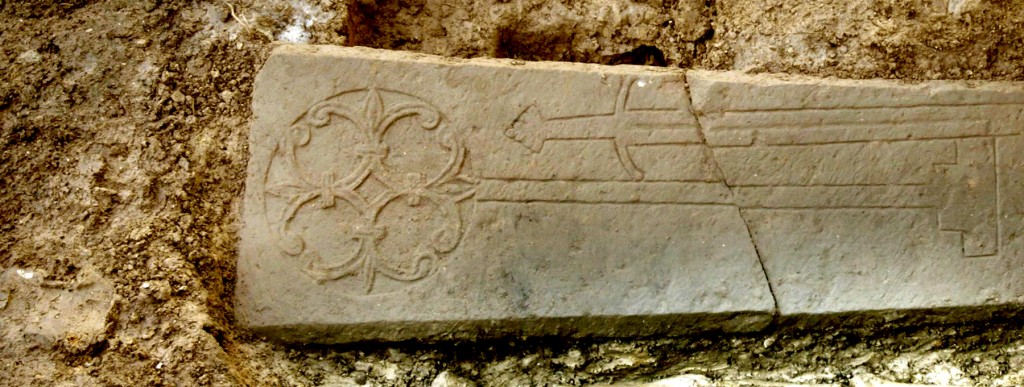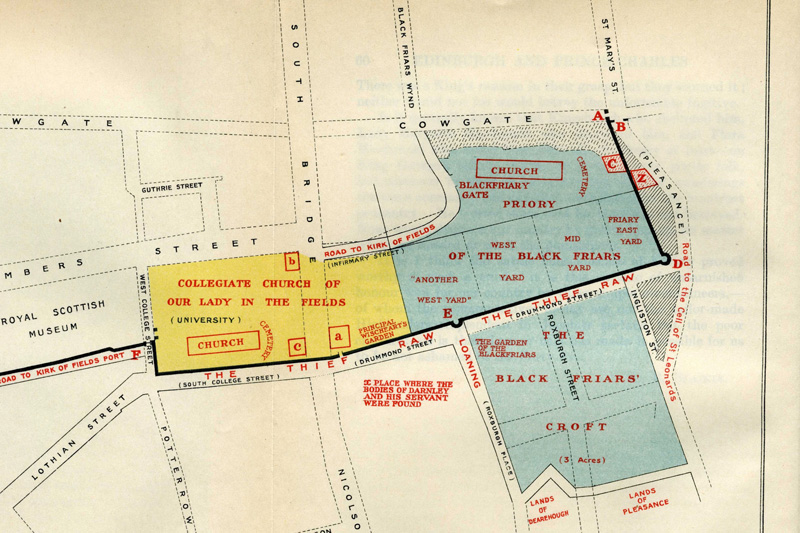History of the Dominicans in Edinburgh
Medieval Blackfriars
In 1230, the Scottish king Alexander II gave the Dominican friars land and a house in Edinburgh to found a Priory. It overlooked the steep valley of the Cowgate to the south of the Royal Mile. Today the site is occupied by Edinburgh University’s Centre for Carbon Innovation on Infirmary Street. From there, Dominican friars preached and celebrated the sacraments for almost 330 years until the Scottish Reformation in 1560.
Archaeology

In 2013 when the Edinburgh Centre for Carbon Innovation was being constructed, part of the chancel of the Priory Church was discovered along with the skeletons of 88 men, women and children. One of these drew a lot of attention. Beside the skeleton of a young adult male, a stone slab with a cross and a knight’s sword carved on it, was found. We now know that this person died sometime before 1278. In fact, we know relatively little about the friars who lived there but it is likely that these men came mainly from the educated merchant classes of Scotland’s cities. Today their presence is commemorated by a plaque and in the name “Blackfriars Street” which once led down to the Priory from the Royal Mile.
Dissolution
 In 1559 a mob went on the rampage and the houses of both the Black Friars and the Grey Friars were sacked. When the Reformation settlement was made, friars were offered a pension of £16 on condition that they live out the rest of their days quietly. Some went abroad, others became ministers of the Kirk, while some continued to minister as best they could to the remaining Catholics. For a while Mary, Queen of Scots, supported two friars at Holyrood. One of these was John Black who was murdered on the same night in 1566 as the Queen’s secretary, David Riccio. By contrast John Craig is now commemorated by a plaque in the High Kirk of St Giles where he became the minister. He wrote a catechism for the Kirk and died at the age of 89 in 1600. The Province of Scotland had come to an end. After 1600, a number of Irish Dominicans ministered in the Western Isles, which for them were more easily accessible by sea. Of course there were also Scots who lived abroad and became Dominicans.
In 1559 a mob went on the rampage and the houses of both the Black Friars and the Grey Friars were sacked. When the Reformation settlement was made, friars were offered a pension of £16 on condition that they live out the rest of their days quietly. Some went abroad, others became ministers of the Kirk, while some continued to minister as best they could to the remaining Catholics. For a while Mary, Queen of Scots, supported two friars at Holyrood. One of these was John Black who was murdered on the same night in 1566 as the Queen’s secretary, David Riccio. By contrast John Craig is now commemorated by a plaque in the High Kirk of St Giles where he became the minister. He wrote a catechism for the Kirk and died at the age of 89 in 1600. The Province of Scotland had come to an end. After 1600, a number of Irish Dominicans ministered in the Western Isles, which for them were more easily accessible by sea. Of course there were also Scots who lived abroad and became Dominicans.
17th Century
 In 1631, Patrick Primrose graduated from Edinburgh University. He was admitted as an advocate in 1635. Just as in England Philip Howard hoped to restore the English Province, Patrick Primrose became a Dominican and dreamed of a Dominican mission in Protestant Scotland. By 1649 he was at Santa Maria sopra Minerva, and in 1650 was appointed Vicar General of the Scottish Province. He ministered in the Lothians and later in Banffshire. When Charles II was restored to the throne, he was appointed a chaplain to the Queen, Catherine of Braganza, which afforded him some protection. However, his ministry worried the Privy Council and in 1670 he was arrested and then released on condition that he go into exile. However, he did not actually leave due to the poor state of his health and died in 1671. His chalice is now in the keeping of the Dominican community in Edinburgh.
In 1631, Patrick Primrose graduated from Edinburgh University. He was admitted as an advocate in 1635. Just as in England Philip Howard hoped to restore the English Province, Patrick Primrose became a Dominican and dreamed of a Dominican mission in Protestant Scotland. By 1649 he was at Santa Maria sopra Minerva, and in 1650 was appointed Vicar General of the Scottish Province. He ministered in the Lothians and later in Banffshire. When Charles II was restored to the throne, he was appointed a chaplain to the Queen, Catherine of Braganza, which afforded him some protection. However, his ministry worried the Privy Council and in 1670 he was arrested and then released on condition that he go into exile. However, he did not actually leave due to the poor state of his health and died in 1671. His chalice is now in the keeping of the Dominican community in Edinburgh.
The Sisters Return
Although Irish Dominicans continued to minister in the West of Scotland it wasn’t until 1910 that a new Dominican house was founded. This was a convent of Dominican Sisters at Hawick from the Congregation of Catherine of Siena whose motherhouse is at Stone. These Sisters were engaged in teaching and nursing.



